In the world of welding, stick welding electrodes are the unsung heroes that hold the key to creating strong and durable welds. These unassuming metal rods come in a variety of types and compositions, each tailored to specific welding tasks and materials
Whether you’re a seasoned welder or just starting on your welding journey, choosing the right stick welding electrode can make all the difference in the quality and longevity of your welds..
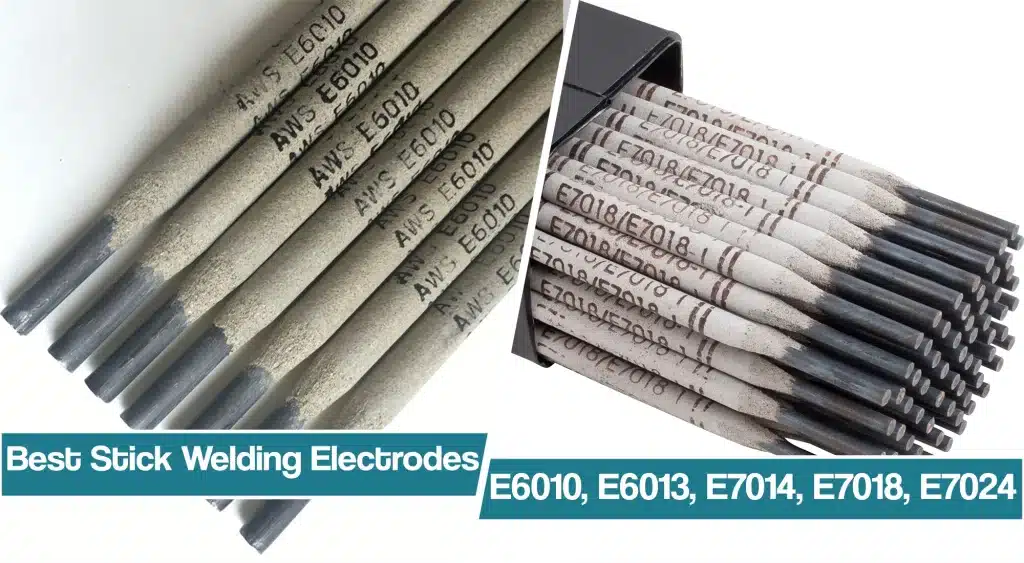
In this article, we will explore the best stick welding electrodes on the market, delving into their unique features, applications, and the benefits they bring to the world of metal fabrication.
Types of Welding Electrodes And Classification
The AWS (American Welding Society) classification system is a standardized system used to identify and classify welding electrodes, including stick electrodes.
Each letter and number in the classification code provides essential information about the electrode’s characteristics, making it easier for welders to select the right electrode for their specific welding needs. Here’s a breakdown of what each letter and number in the AWS classification represents:
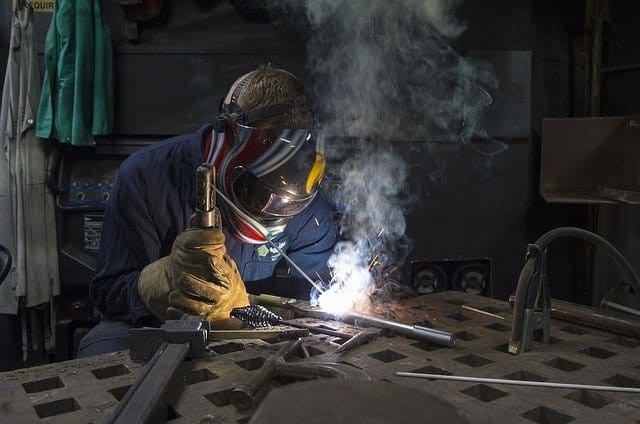
- Electrode Prefix Letter(s):
- The prefix letter(s) indicates the intended use and properties of the electrode. The most common prefix letters include:
- E: This indicates that the electrode is for arc welding.
- R: Signifies a rutile (titanium dioxide) coating.
- B: Represents a basic (low-hydrogen rod) coating.
- C: Indicates a cellulose-based coating.
- L: Designates low alloy steel electrodes.
- M: Indicates that the electrode has been designed for military use.
- The prefix letter(s) indicates the intended use and properties of the electrode. The most common prefix letters include:
- First Two or Three Digits:
- The first two or three digits represent the minimum tensile strength of the weld metal produced by the electrode in thousands of pounds per square inch (psi). For example, in the classification “E7018,” the “70” indicates a minimum tensile strength of 70,000 psi.
- Last Digit(s):
- The last digit(s) in the classification code provide additional information about the electrode’s characteristics, such as:
- 1: Indicates an all-position electrode.
- 2: Specifies that the electrode can be used in horizontal and flat positions.
- 3: Indicates an electrode suitable for flat welding only.
- 4: Suggest an electrode designed for use with specific welding positions (other than those indicated by 1, 2, or 3).
- 5: Specifies a covering or special characteristic, such as increased ductility.
- 6: Signifies a moisture-resistant electrode coating.
- 8: Indicates a low-alloy steel electrode.
- 9: Specifies a welding electrode used for a specific application, such as for high carbon, molybdenum, or other alloy steels.
- The last digit(s) in the classification code provide additional information about the electrode’s characteristics, such as:
- Suffix Letter(s):
- In some cases, a suffix letter may be added to provide additional information about the electrode, such as its chemical composition or other unique properties.
Best Stick welding rods
The AWS classification recognizes more than 100 different Shielded metal arc welding rods that have different properties that fit different uses. However, as a beginner, hobbyist, or DIY lover, you are likely to use one or two types, that can cover most of your daily stick welding. Additionally, most industrial applications use up to 5 different electrode types, and today, we’ll closely talk about their properties.
6013 – Best Stick Welding Rods For Beginners
Stick welding is a manual welding process, which means you’ll have to control the welding arc, including travel angle, deposition rate, travel speed, and other welding parameters by hand. That makes SMAW one of the harder welding processes to master, but if you are new, we recommend 6013 rods.
E6013 is an all-around stick rod that can be used with DCEP, DCEN & AC, and in all positions. This rod is an excellent choice for light fabrication, maintenance, repairs, and construction.
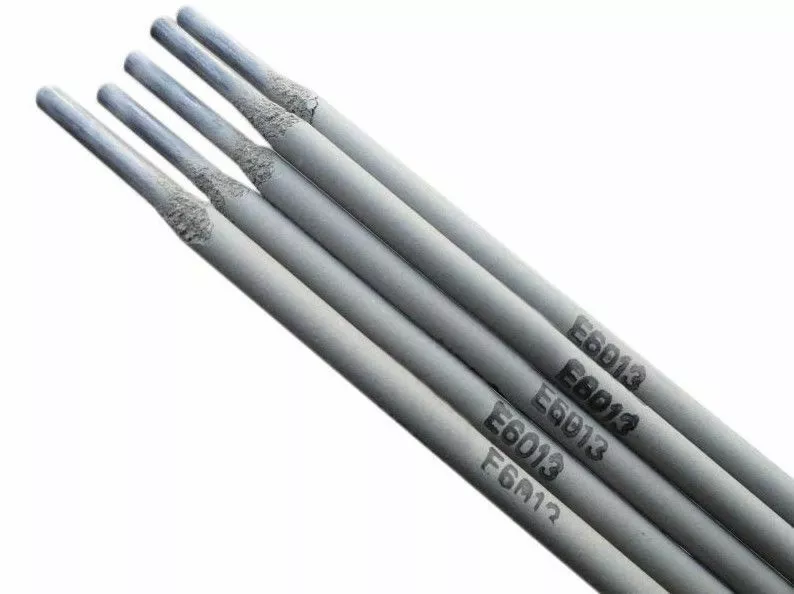
But what makes it perfect for beginners is its highly forgiving arc and easy arc start characteristics. The electrode’s rutile coating ensures it’s straightforward to use with a smooth arc.
A soft arc of E6013 makes welding easy, and shallow penetration allows it to run very smoothly. It also produces minimal spatter and an easy-to-remove slag. So, if ever in doubt about what rod you need for your general-purpose welding at home or garage, just go with 6013.
However, soft arc and shallow penetration are not the characteristics you are looking for in heavy fabrication and thick metal welding. If your everyday tasks include welding thicker pieces or pipe welding, you’ll have to look further. Nonetheless, if you are a hobby welder or a beginner, you will enjoy 6013s.
Pros:
Easy arc start
Forgiving arc, resistant to operator mistakes
Can work with DCEP, DCEN, and AC
Can be used in all positions
All-around welding rod for beginners
Cons:
Shallow penetration
Soft arc
E6010 – Root Pass Stick Welding Rod
The notorious E6010 is one of the most widely used stick rods in the industry, due to its penetration properties. This is an all-position, DC-only rod that produces deep penetration and fast-freeing cellulose flux. These characteristics make it one of the most used stick rods for root pass welding, as it was developed for the pipe welding industry for welding API grades A25, A, B, and X42 pipe and general structural fabrication.
What makes E6010 also a good root pass choice is the very light slag. The slag peels easily, so you don’t have to worry about slag inclusions and other defects in the multi-pass welding techniques. Still, the slag will produce good protection for the weld bead, and with deep penetration, you are set for success in a multi-pass weld.
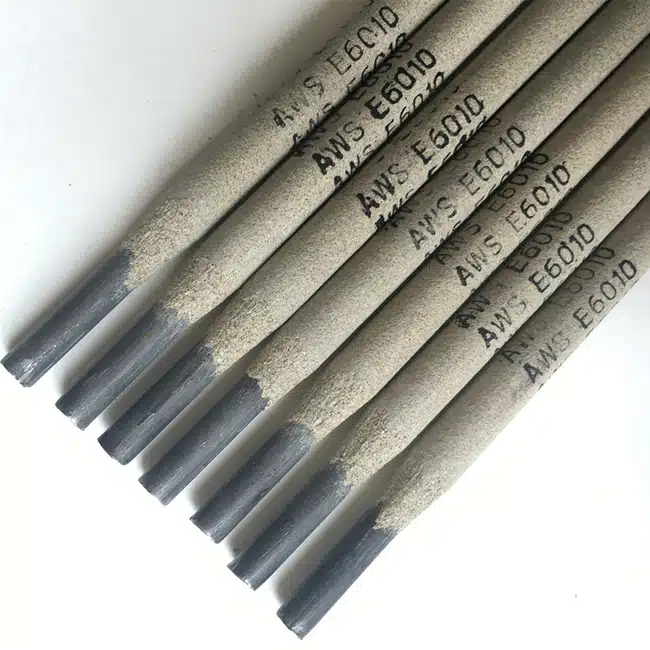
The only drawback of E6010 is coming from the latest trends in the world of welding – inverter welders. The inverter welders simply cannot stabilize the aggressive arc these electrodes create, causing highly inconsistent arc and unpredictable results. However, some of the issues have been solved by introducing arc force and hot start features, that compensate for the voltage fluctuations that may cause inconsistencies, so many new inverter welders claim they can run 6010s. However, it will take you some time and patience to get everything right.
Pros:
Deep penetration
All position electrode for root pass
Fast-freeing flux
Flux coating is easily peeled
Excellent arc down
Cons:
Can be hard to run on inverter welders
E7018 – Best Welding Rod for Rusty Metal And Fill Pass
E7018 is a low-hydrogen electrode that produces high-quality X-ray welds. These stick electrodes provide the chemical properties necessary for the applications, along with the low hydrogen levels needed to prevent issues like hydrogen cracking. As a general rule, E7018 stick electrodes are a good choice for structural steel applications due to their smooth, stable, and quiet arc, and their low spatter levels.
These electrodes are designed to be used in all positions on AC or DC reverse polarity welding current. Even though they can be used with AC to deal with arc blow, welding with a DCEP current can make it easier to control the arc and gain a more appealing weld bead because the direction of the current flow is constant.
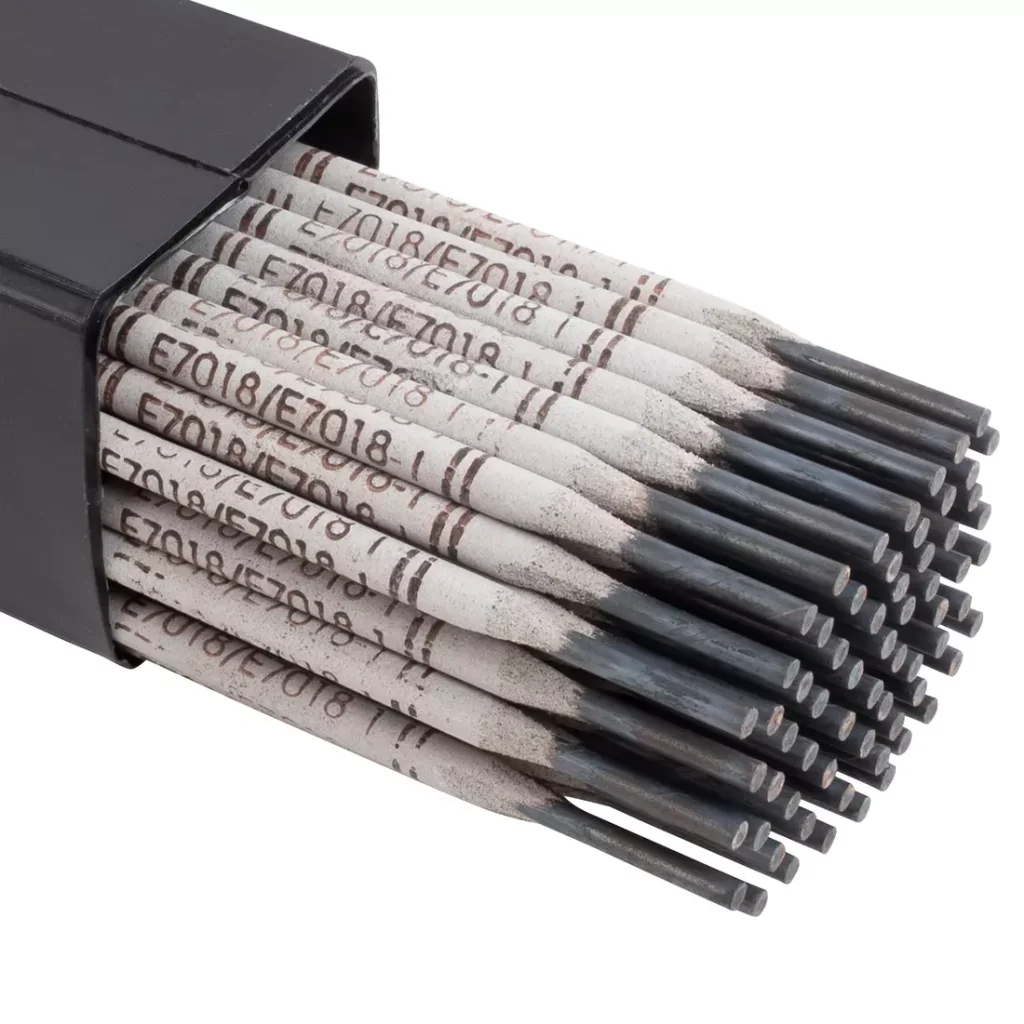
The puddle that E7018 creates is very fluid and freezes slowly. The layer of thick slag easily removes rust and other contaminants from the top of the base metal. Additionally, the thick slag also prevents the formation of new rust.
Because of the low-hydrogen designation of E7018 stick electrodes, these products typically ship from the filler manufacturer in a hermetically sealed package. To protect from moisture damage, it is important to keep that package intact until the products are ready for use. It is also important to keep the stick electrodes in a dry storage area. If you open the package, you’ll have to store them in a rod oven. Per most welding codes, you can use them right out of the package for only two hours, and then you need to store them in an oven at 250F.
Pros:
Smooth, stable, and quiet arc
Low spatter levels
Can be used in all positions
Burns through rust, and thick slag prevents the formation of new rust
Cons:
They should be used within 2 hours after opening the box, and later stored in a rod oven
E7014 – High-deposition, fast-speed welding Rod
E7014 is a versatile, all-position electrode that has a rutile base with an iron powder addition that increases welder-appeal with an outstanding deposition rate and travel speed. This is a multipurpose stick welding electrode, popular among beginners and professionals. It can be used for all types of steel and is highly versatile due to its tensile strength, polarity, and other properties. You can use it with DCEP, DCEN, and AC polarities.
The 7014 has a medium penetration, making it versatile to use. It penetrates deep enough to be used for multilevel welds, making it a very important tool for your arsenal. The thick deposit from the iron powder creates a thick layer of slag that is easy to remove after the weld, making welding easier without getting an ugly result. The weld rod is mainly used for fillet welding and structure welding works.
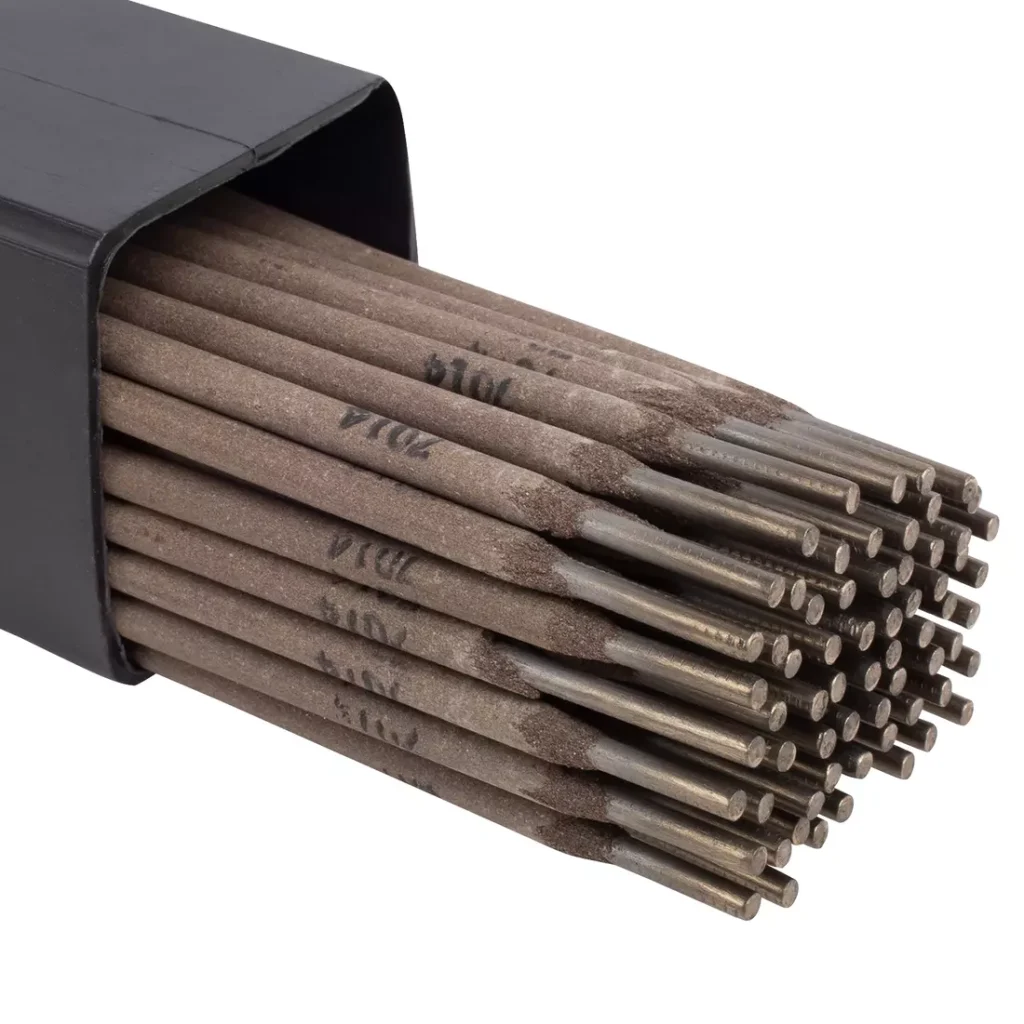
The only drawback compared to electrodes such as E7024 is the limited penetration. Medium to low penetration means you won’t be able to weld thicker pieces, but for medium-thickness steel, it will do more than just fine. Therefore, consider it as an alternative to 6013, just with a different composition and higher deposition rates.
Pros:
Excellent deposition rates and speed
Can be used for all types of mild steel
Can be used regardless of the welding position
Medium penetration for multipass welds
Good for a fillet welding job
Cons:
Limited penetration
E7024 – Heavy-Duty Welding Rods For Big Projects
E7024 electrode coverings contain large amounts of iron powder in combination with ingredients similar to those used in E6013 electrodes.
This electrode has good weldability and superior mechanical properties and is particularly useful in obtaining increased penetration with little or no root porosity in horizontal or positioned fillets.
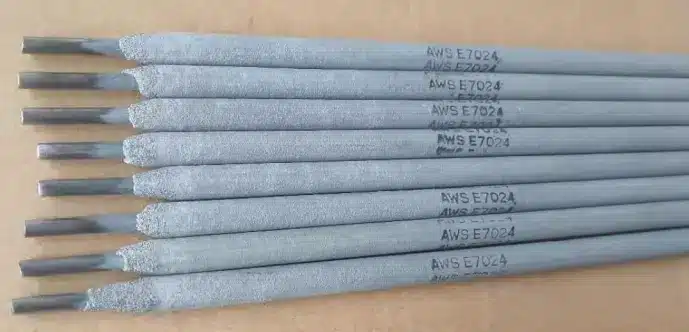
The flux layer on E7024 is very thick and usually amounts to about 50% of the weight of the electrode, resulting in higher deposition efficiency. Like E7014, E7024 electrodes are well suited for making fillet welds. however, the use of this electrode is limited to the flat or horizontal position. That’s why it is usually used in oil & gas tank bottom plate welding, fillet welds in shipyards, and structural work in buildings & bridges. Welding on groove weld will result in the issue of lack of penetration and shabby weld profile.
These electrodes are characterized by a smooth, quiet arc, very low spatter, and low arc penetration. They can be used with high travel speeds. Electrodes of this classification can be operated on AC or DCEN.
Pros:
Thick flux coating for high molten metal deposition
Used in various industrial applications
Excellent bead appearance and self-cleaning slag
AC or Direct Current Electrode Negative (DCEN)
Cons:
Limited penetration
Shouldn’t be used for overhead welding
Quick Summary
What are the best stick electrodes for beginners?
While there are various options out there, inexperienced welders usually do well with E6013 welding rods. They provide a highly forgiving arc and easy start that makes shielded metal arc welding easy.
What are the best stick rods for root pass?
Most pipeline welders use E6010 electrodes when welding root pass in pipes and other applications. These electrodes provide deep penetration, which is suitable to make a foundation for the following passes.
What is the best stick rod for rust and dirt?
E7018 is a versatile rod that burns through rust and dirt, and it also provides good results in multi-pass operation for fill passes.
What are the best electrodes for high-speed operations?
E7014 and E7024 electrodes contain very thick flux and a high amount of iron powder, which makes them excellent choices when high deposition and high welding speeds are required. The 7014 is an all-around, all-position electrode, while the 7024 is limited to a flat or horizontal position.
What is the Best electrode For Thin and Sheet Metal?
The 6013 electrode is best used for light to medium penetration on thin or sheet metal pieces. These are commonly used in manufacturing truck frame bodies, metal furniture, storage tanks, farm implementations, or where aesthetics are critical.
Resources:
- https://www.tws.edu/blog/welding/what-is-the-best-welding-rod-for-a-beginner/
- https://www.industrialmetalsupply.com/blog/differences-of-stick-welding-7018-vs-6013
- https://www.millerwelds.com/resources/article-library/stuck-on-stick-easy-answers-to-not-so-simple-questions-about-common-electrodes
- https://www.tws.edu/blog/welding/what-you-need-to-know-about-welding-electrodes/
- https://www.thefabricator.com/thewelder/article/consumables/classifying-popular-stick-electrodes-helps-welders-with-decision-making





